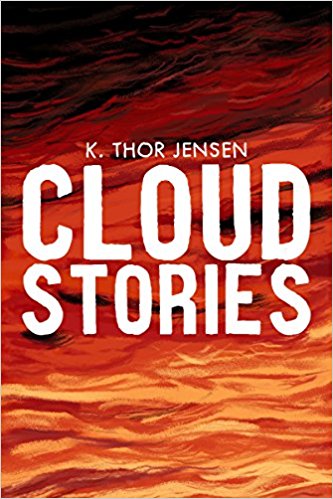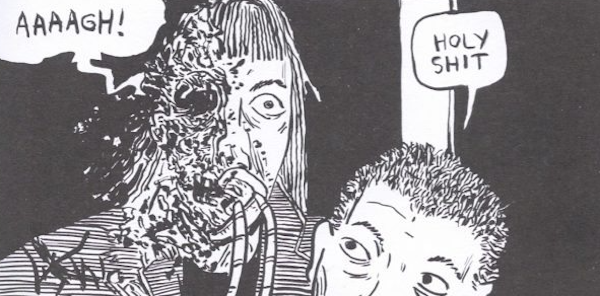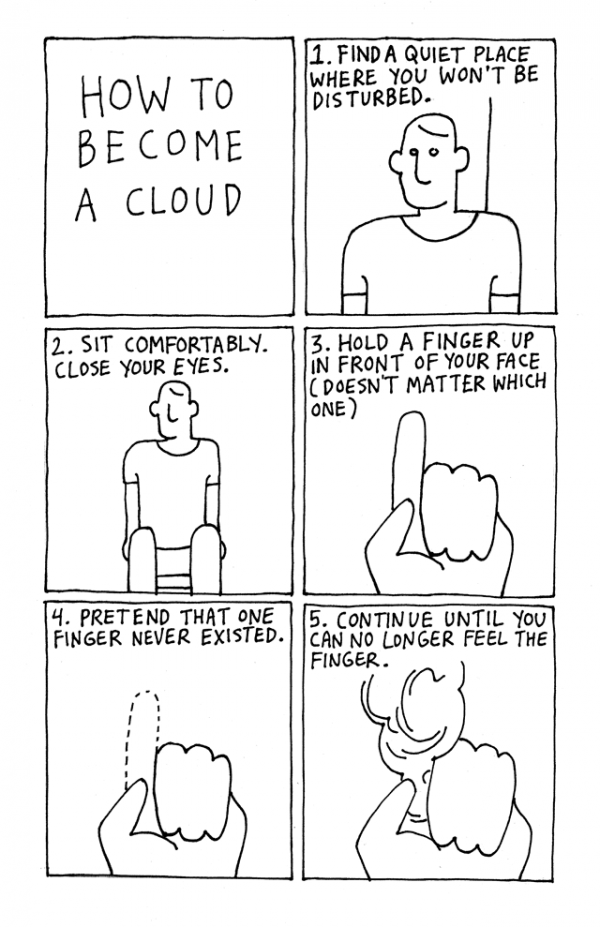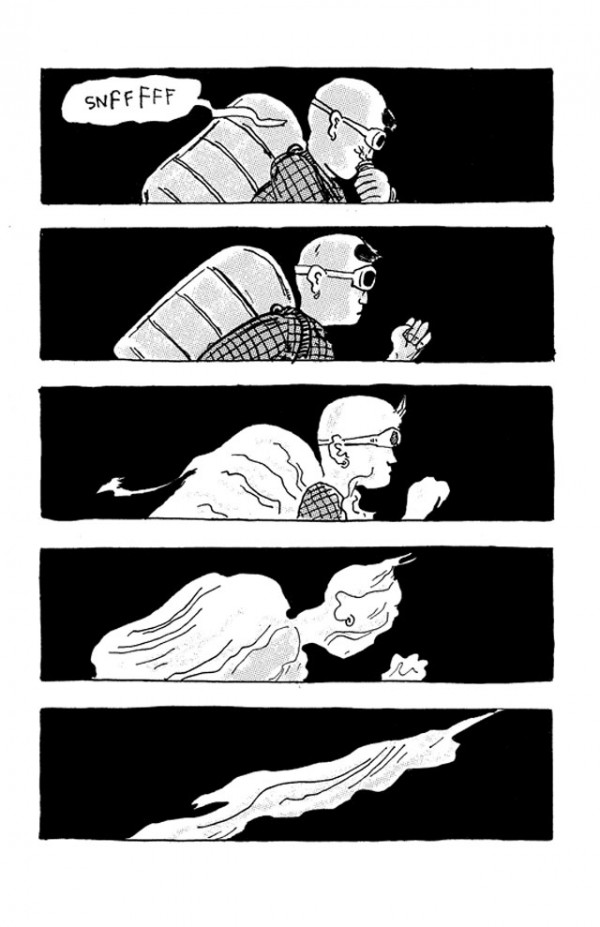
April 1, 2017
 CR Sunday Interview: K. Thor Jensen
CR Sunday Interview: K. Thor Jensen


It's been ten years since I spoke in interview-fashion with
K. Thor Jensen, the youngest comics-maker of the early 1990s Seattle comics scene of which I stood on the periphery for most of that decade. He has a new book out, a self-published and crowd-funded work called
Cloud Stories.
In sharp contrast to the epic-length single story
Red Eye, Black Eye about which we talked in 2007,
Cloud Stories is a thematically connected group of short stories, showing off the cartoonist's ability to craft strong visual imagery and work in stylistic variations of his comics' solid, workman-like look. I liked big swathes of it, and I love how direct and clear Jensen seems to be about his work and what he'd like to do with it. I hope we're both still around for our next chat in 2027. I tweaked this a tiny bit for flow. -- Tom Spurgeon
*****
TOM SPURGEON: Thor, the last time we talked for CR
was a freaking decade ago. That time shared some surface similarities with where we found ourselves now. For one thing, I have no idea what you're doing beyond the return address and the fact this book showed up, and I was working from a similarly blank slate a decade ago. I do remember you were on your way to becoming a dad… can you provide a snapshot of your life, and where comics fits into it?
K. THOR JENSEN: I'm still a dad! I have two lovely children, Henry and Rose. They're both nine. We moved from New York City to
San Juan Island, a tiny landmass between Seattle and Vancouver, after the financial crash of 2008 obliterated our lives. Things are good here. It's quiet and people are nice.
SPURGEON: Red Eye, Black Eye
was a sustained narrative but it looks like this book might have developed
similarly. Am I right in thinking this is work that suggested a connective thread after a while, or was it developed that way from the beginning? At what point did you see something roughly equivalent to the final book?
JENSEN: I was drawing short stories just to draw, because I love to do it. They went in this sequence, I think: "Bolus," "KSOFM," "Punchin'," "Queer Gaspers," "Ghost of Emptiness." After that fifth one I noticed there was a loose thread of those cloudy forms showing up, completely unintentionally. And then I spent the next couple years dicking off before deciding to pick them back up again and make a book. When we launched on Kickstarter in 2013, the book was intended to be 120-odd pages and the final product is nearly twice that. There are also 4-5 stories that I couldn't get to come together the way I wanted and just had to be mercy killed.
SPURGEON: Has your worldview changed as a parent in a way you can see that change in your work? For that matter, I don't know how self-reflective you are concerning your own work. Does work stay with you for a period after you complete it? Does talking about it in interviews bring it back into your head?
JENSEN: I'm not sure how to put into words how parenthood has changed what I do. I think comics are a much smaller part of my life, but my kids love them -- and draw them -- so it's interesting.
I do life drawing with my kids and it's really great and inspiring to see them learning how to observe and translate onto the page. I think watching them draw has given me some impetus to sort of re-discover how to do it and enjoy it.
SPURGEON: Can I ask why you self-published this one? I think the last one was one of the last works to squeak from the old Alternative Comics, or at least found purchase with one of the Alternative Comics refugee homes. Correct me if I'm wrong there. But there seem to be a number of small houses; were those an option, or was it self-publishing all the way?
JENSEN: Alternative is still going! Under the fine auspices of Marc Arsenault, who will be handling the Diamond distribution and digital for Cloud Stories because I am bad at that stuff. For me, I just had no idea if anybody on Earth was going to be interested in this book, and Kickstarter seemed like a workable financial model for somebody like me with a fanbase that would be comfortable in ponying up $20 up front. I really like what Spike Trotman -- who has been insanely successful on that platform -- says: if your Kickstarter failed, take that as a blessing because you dodged a bullet not printing something the market didn't want. I was incredibly gratified to see the project funded with lots of small pledges, and then proceeded to deliver the book three years late like an asshole.
SPURGEON: Have you enjoyed putting the work out yourself. I find as cartoonists get older a lot of them want to be more involved in more aspects of what they do. Does taking on this role give you a different insight into the overall creative act of placing work in folks' hands?
JENSEN: I hate it! [Spurgeon laughs] Mailing books sucks ass! Amazon orders like nine at a time every week instead of a bunch at once! Mailing a book to Australia costs $22! I'm never doing this again.
 SPURGEON: There are a number of different basic styles and approaches on display. Was that purposeful, or does range of styles reflect how you work when you're not trying to sustain a tone across an entire, single work?
SPURGEON: There are a number of different basic styles and approaches on display. Was that purposeful, or does range of styles reflect how you work when you're not trying to sustain a tone across an entire, single work?
JENSEN: Red Eye, Black Eye was 300+ pages of six-panel 2x3 grids. When I was done with that book I wanted to stretch out in a bunch of different ways. Some of the earliest work in
Cloud Stories, most notably "KSOFM" and "Punchin'," was drawn in that sort of reactionary period. When you look back across my body of work, though, I think that's the only thing that's really constant. I like to play, I like to experiment, I like to find what's right for a story or a feeling rather than try to force it into something I'm comfortable with.
SPURGEON: I know you can be self-reflective about your work: is there one of those styles with which you feel most comfortable? Is there one looking back that drives you nuts? I liked the Porcellino one-pager and the kind of heft you get with shading in that Double-Zero story.
JENSEN: Not really, and I hope I never get too comfortable! For me the process is just as important and interesting as the product, so everything I do should be challenging. I'm actually working on an anthology piece right now where I'm going back to the style of my late '90s weekly strip, so that's interesting in itself -- what do I do differently now that I didn't 20 years ago?
There are definitely some parts of the book that I cringe at, but I got to a point where I just had to close the door and get it out. I could have fucked with it forever. It could have been 500 pages.
SPURGEON: Is there an influence you know of in your work that may be hard for the rest of us to see? Has your relationship to your influences changed as you've spent years doing this?
JENSEN: My biggest influences are literary more than visual, probably because I'm a workmanlike visual stylist and a better storyteller. The short stories of
John Collier and
Saki have always been my model for their clarity and dedication to taking a premise and running with where it leads you.
SPURGEON: One thing that's nice about this book is that with the different strategies you get to explore image-making a bit more -- it's not about getting through the page all the time, it can be about stopping and reflecting and looking. Some of the stories are basically just images, and you make good use of the stop and stare effect in "The Oil." Would it be fair to say this book shows off a variety of effects in terms of pacing and visuals on the page? Is that a satisfying way for you to work?
JENSEN: The creation of this book, for me, was as much play as work. I wanted to try a bunch of stuff and keep it connected by a thematic through-line to see how many different ways I could use it. I'm really happy with the results. I don't think I'll ever do a book this way again, but it was a really satisfying way to make comics for a couple of years.
 SPURGEON: We just lost Bernie Wrightson, who spent a lot of time drawing the living clashing with the dead on an almost sub-atomic level, all from safely within the Frazetta tradition. Your art doesn't embrace those exact same values, but there are a number of times when a person is mixed with an abstract effect, or you draw this really tangible visual that represents a sense memory. Is this kind of representation important to you, these visuals that break with the rest of what we're seeing?
SPURGEON: We just lost Bernie Wrightson, who spent a lot of time drawing the living clashing with the dead on an almost sub-atomic level, all from safely within the Frazetta tradition. Your art doesn't embrace those exact same values, but there are a number of times when a person is mixed with an abstract effect, or you draw this really tangible visual that represents a sense memory. Is this kind of representation important to you, these visuals that break with the rest of what we're seeing?
JENSEN: Oh yeah. Again this goes back to
Red Eye, Black Eye, which was a very literal book. Everything was very deliberately stripped away from that to produce something that put the reader in a real obstacle-free flow state for fast, easy reading. With this book, which is literally about obfuscation, uncertainty, amorphousness, it gave me an opportunity to stretch in those interesting directions that comics are so good at doing. Some of my favorite pieces in the book are the ones that push that boundary, like the depression bits in "The House In The Night," or the weird inhuman tongue in "Jubilation."
SPURGEON: Are you still working in a non-comics creative industry? How does that kind of secondary exposure have an impact on how you view your comics-making. It seems, for instance, you've always been happy to pivot away from a vision of your comics being all-time, money-generating hits, in part because you've experienced other models that weren't about maximum profits.
JENSEN: Yeah, comics are a hobby for me pretty much 100% now. I write for a living, mostly, and it's satisfying for a voracious brain to constantly absorb new information and get paid for it. I love that it's given me the freedom to draw these weird-ass comics and spend lots of time with my kids.
SPURGEON: Talk to me about "Seeds." Where did that one start with you, what was the compelling interest for you to move forward? I know that you enjoy conversation, you said so last time; is this a reflection of that interest, just following someone all the way out there? Can you talk about the spare, semi-scratchy style you're using to draw that story?
JENSEN: The source material for the story there is a manuscript by a guy named John North Wright who I discovered on the Internet back in 1999. He was a guy in Port Huron, Michigan who was convinced that Bob Dylan was telepathically spying on him, stealing his song lyrics (and eventually his wife!) I ordered some videos and audio cassettes from him before he died and wrote a little thing on my website, and eventually other collectors of his stuff got in touch with me to trade.
One sent me all that remained -- about 22 pages -- of his memoir, "Dr. Kaballah Meets The Telepathic CIA," which this story is recounted in. It's such a singular, intense document that dealt with some of the themes in the book -- identity loss, fear of the unknown -- in a completely different way than I could. I wanted to present it in a way that was narratively clear but also unsettling, so the visual style didn't take long to develop. I sketched out the shot of John drinking the blood from the hearts and basically went "Yeah, that's it."
SPURGEON: "Fable 27" is the other one that left me particularly curious. I'd love to know if there was an act of visual problem-solving here, and what kind of effect you get from that particular style of drawing.
JENSEN: So I did a ton of research into folklore and mythology when I was working on this book, trying to explore how different cultures perceived and interpreted clouds. I came across that poem by
John Gay and I was really struck by the language in it and the way it moved, so I wanted to adapt it in a way that let it breathe but was still fun to look at. There was actually another piece in the book that used a similar full-page treatment that never came together to my satisfaction.
 SPURGEON: Would you have ended up in roughly the same place if you had been born ten years later, ,do you think?
SPURGEON: Would you have ended up in roughly the same place if you had been born ten years later, ,do you think?
JENSEN: God, I don't know! [Spurgeon laughs] One of the things that I'm most proud of about
Cloud Stories is that, if you took the dates out, it would be pretty tough to tell exactly when the book was published. It doesn't seem like a particular product of any particular time or movement. I'm so blessed to have had the support I did as a young cartoonist, but the idea of a "career" just doesn't make any sense to me in the field like it did in the '90s.
SPURGEON: We're about a quarter century removed now from the primetime Seattle cartooning scene of the 1990s of which you were a part. Last time we talked we talked about the high-retention of comics-makers from that group of young comics enthusiasts, which might be slightly down now. Although I think we'll see more work from here, I don't think of Megan Kelso, say, as active anymore. Are you still hoping to make comics for life?
JENSEN: Oh yeah. I'm thinking about some new stuff, but it's going to be on whatever terms I feel comfortable doing it. Might do a serialized webcomic again, might do a horror genre floppy. Might collaborate on something with my wife. Who knows?
SPURGEON: I have to know… What was the best comic you read since we last interviewed?
JENSEN: Lord, the best in ten years?
SPURGEON: [laughs] That's sort of the idea.
JENSEN: I think
Rosalie Lightning is an incredible accomplishment, a brutal and harrowing read by one of the greatest working today. But so much amazing shit has come out in the last decade! So many amazing cartoonists debuted! So many great new publishers are doing the do.
Fucking comics, man! They're amazing!
*****
*
Cloud Stories, K. Thor Jensen, Self-Published Paperback, 216 pages, 0692642323, 9780692642320, $20, January 2017.
*****
* cover and images all from
Cloud Stories
*****

*****
*****
posted 8:00 pm PST |
Permalink
Daily Blog Archives
November 2019
October 2019
September 2019
August 2019
July 2019
Full Archives


